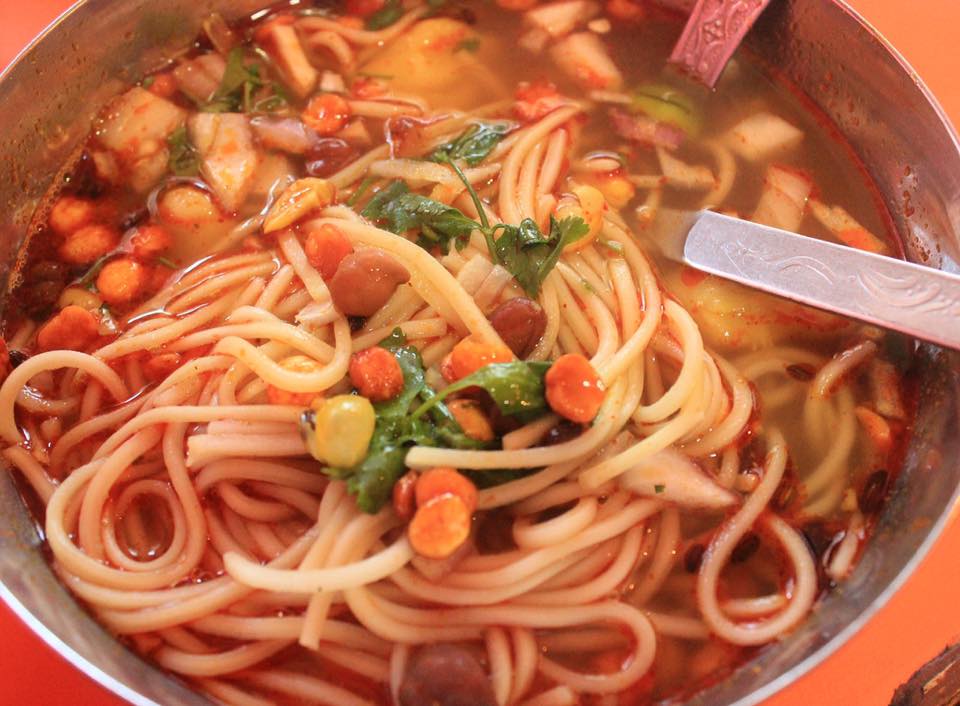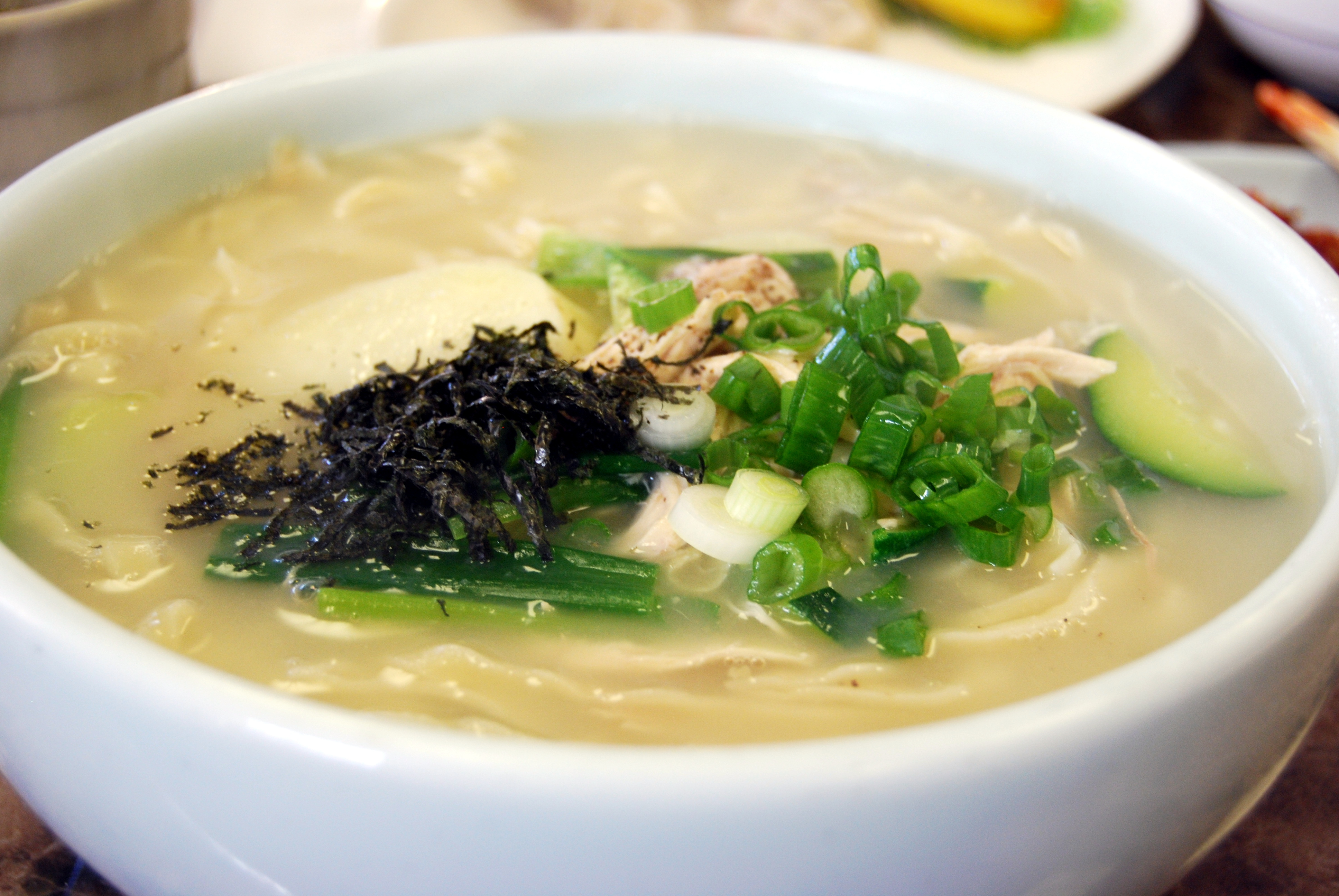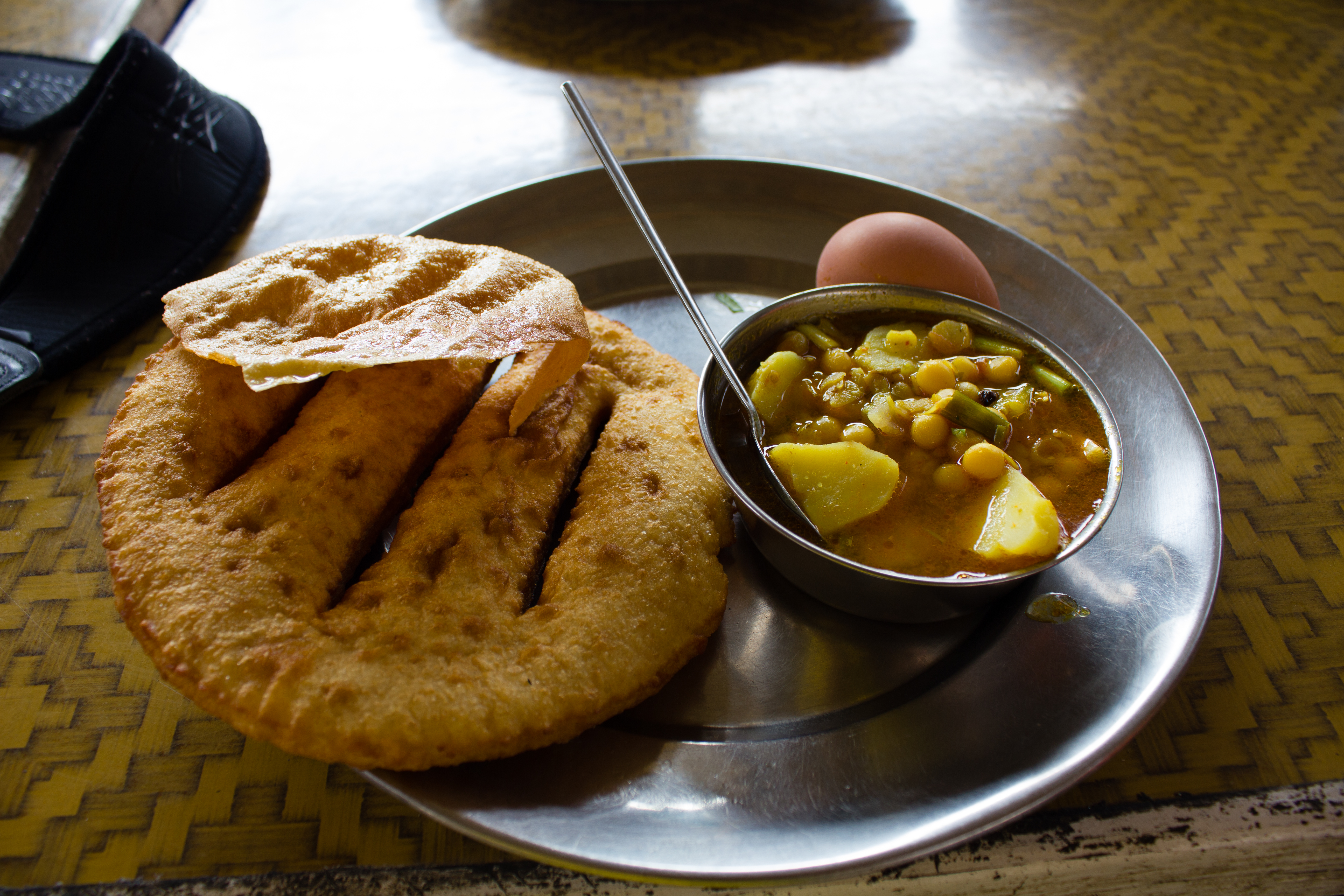|
Thenthuk
Thenthuk () or hand-pulled noodle soup (thukpa), is a very common noodle soup in Tibetan cuisine, especially in Amdo, Tibet where it is served as dinner and sometimes lunch. The main ingredients are wheat flour dough, mixed vegetables and some pieces of mutton or yak meat. Vegetable thenthuk is a common modern-day option too. Preparation Making the soup consists of mixing the flour, kneading the dough, chopping the vegetables and meat and boiling the soup. The cook starts working with the dough when everything boiling in the soup is well cooked. They shape the dough, flatten it, pull it and cut it off, right into the boiling soup. As soon as this is finished, the noodle soup is ready to cool down and be served. Nepalese thukpa The Nepalese version of thukpa () contains chili powder, masalas, and noodles with gram and pea soup which gives it a hot and spicy flavor. The most typical Nepali thukpa is found in Sankhuwasabha district. However, the thukpa found in Kathmandu Valley ... [...More Info...] [...Related Items...] OR: [Wikipedia] [Google] [Baidu] |
List Of Tibetan Dishes
This is a list of Tibetan dishes and foods. Tibetan cuisine includes the culinary traditions and practices of Tibet and its peoples, many of whom reside in India and Nepal. It reflects the Tibetan landscape of mountains and plateaus. It is known for its use of noodles, goat, yak, mutton, dumplings, cheese (often from yak or goat milk), butter (also from animals adapted to the Tibetan climate) and soups. The cuisine of Tibet is quite distinct from that of its neighbors. Tibetan crops must be able grow at the high altitudes, although a few areas in Tibet are low enough to grow such crops as rice, oranges, bananas, and lemon. Since only a few crops grow at such high altitudes, many features of Tibetan cuisine are imported, such as tea, rice and others. The most important crop in Tibet is barley. Flour milled from roasted barley, called '' tsampa'', is the staple food of Tibet. It is eaten mostly mixed with the national beverage Butter tea. Meat dishes are likely to be yak, goat, ... [...More Info...] [...Related Items...] OR: [Wikipedia] [Google] [Baidu] |
Thukpa
Thukpa ( Tibetan: ཐུག་པ; IPA: /tʰu(k̚)ˀ˥˥.pə˥˥/ ) is a Tibetan noodle soup, which originated in the eastern part of Tibet. ''Amdo thukpa'', especially '' thenthuk'', is a variant among the Indians, especially Ladakhis and the Sikkimese. ''Thukpa'' can be prepared in both vegetarian and non-vegetarian variations; the most popular non-vegetarian variation includes chicken. Varieties of ''thukpa'' include: * '' Thenthuk'' (): Hand-pulled noodle * ''Gyathuk'' (): Chinese noodle * * '' Bhakthuk'' (): Hand-rolled pinched noodle (like gnocchi) * ''Tsapthuk'' (): chopped noodle Etymology Thukpa has been described as a "generic Tibetan word for any soup or stew combined with noodles". Regional traditions Indian thukra In India, the dish is consumed by people of Nepalese and Tibetan origin in the state of Sikkim, the district of Darjeeling and the union territory of Ladakh Ladakh () is a region administered by India as a union territory and constitutes an e ... [...More Info...] [...Related Items...] OR: [Wikipedia] [Google] [Baidu] |
Noodle Soup
Noodle soup refers to a variety of soups with noodles and other ingredients served in a light broth. Noodle soup is a common dish across East Asia, Southeast Asia and the Himalayan states of South Asia. Various types of noodles are used, such as rice noodles, wheat noodles and egg noodles. Varieties East Asia China There are myriad noodle soup dishes originating in China, and many of these are eaten in, or adapted in various Asian countries. * Ban mian (板麵) – Hakka-style, flat-shaped egg noodles in soup. * Chongqing noodles * Cold noodle (冷面/冷麵) – Shanghai-style, flat noodle stirred with peanut butter sauce, soy sauce and vinegar, served cold. * Crossing-the-bridge noodles () – ingredients are placed separately on the table, then added into a bowl of hot chicken stock to be cooked and served. The ingredients are uncooked rice noodles, meat, raw eggs, vegetables and edible flowers. The stock stays warm because of a layer of oil on top of the bowl. Typical cuisi ... [...More Info...] [...Related Items...] OR: [Wikipedia] [Google] [Baidu] |
Tibetan Cuisine
Tibetan cuisine includes the culinary traditions and practices of the Tibetan people in the Tibet region. The cuisine reflects the Tibetan landscape of mountains and plateaus and includes influences from neighbors (including India and Nepal where many Tibetans abide). It is known for its use of noodles, goat, yak, mutton, dumplings, cheese (often from yak or goat milk), butter, yogurt (also from animals adapted to the Tibetan climate), and soups. Vegetarianism has been debated by religious practitioners since the 11th century but is not prevalent due to the difficulty of growing vegetables, and cultural traditions promoting consumption of meat. Crops must be able to grow at high altitudes, although a few areas are at low enough altitude to grow crops such as rice, oranges, bananas and lemons. The most important crop is barley. Flour milled from roasted barley, called '' tsampa'', is the staple food of Tibet, as well as '' Sha phaley'' (meat and cabbage in bread). '' Balep'' ... [...More Info...] [...Related Items...] OR: [Wikipedia] [Google] [Baidu] |
Noodle Soup
Noodle soup refers to a variety of soups with noodles and other ingredients served in a light broth. Noodle soup is a common dish across East Asia, Southeast Asia and the Himalayan states of South Asia. Various types of noodles are used, such as rice noodles, wheat noodles and egg noodles. Varieties East Asia China There are myriad noodle soup dishes originating in China, and many of these are eaten in, or adapted in various Asian countries. * Ban mian (板麵) – Hakka-style, flat-shaped egg noodles in soup. * Chongqing noodles * Cold noodle (冷面/冷麵) – Shanghai-style, flat noodle stirred with peanut butter sauce, soy sauce and vinegar, served cold. * Crossing-the-bridge noodles () – ingredients are placed separately on the table, then added into a bowl of hot chicken stock to be cooked and served. The ingredients are uncooked rice noodles, meat, raw eggs, vegetables and edible flowers. The stock stays warm because of a layer of oil on top of the bowl. Typical cuisi ... [...More Info...] [...Related Items...] OR: [Wikipedia] [Google] [Baidu] |
Amdo
Amdo ( �am˥˥.to˥˥ zh , c = 安多 , p = Ānduō ), also known as Domey (), is one of the three traditional Tibetan regions. It encompasses a large area from the Machu (Yellow River) to the Drichu (Yangtze). Amdo is mostly coterminous with China's present-day Qinghai province, but also includes small portions of Sichuan and Gansu provinces. In the 7th century, Amdo became a part of the Tibetan Empire until its dissolution in the 9th century. A local Tibetan theocracy called Tsongkha ruled the region from 997 to 1104. In the 13th century, Mongol forces conquered the area, which led to the beginning of a priest and patron relationship. From the 14th to the 16th century, the Ming Dynasty controlled some border areas of Amdo while Mongol presence remained significant. In the 1720s, the Yongzheng Emperor of Qing dynasty seized Amdo from the Dzungars and began forming the modern boundaries of Qinghai. He allowed most of the area to be administered by a series of local Tibet ... [...More Info...] [...Related Items...] OR: [Wikipedia] [Google] [Baidu] |
List Of Soups
This is a list of notable soups. Soups have been made since ancient times. Some soups are served with large chunks of meat or vegetables left in the liquid, while others are served as a broth. A broth is a flavored liquid usually derived from boiling a type of meat with bone, a spice mix, or a vegetable mix for a period of time in a stock. A potage is a category of thick soups, stews, or porridges, in some of which meat and vegetables are boiled together with water until they form a thick mush. Bisques are heavy cream soups traditionally prepared with shellfish, but can be made with any type of seafood or other base ingredients. Cream soups are dairy based soups. Although they may be consumed on their own, or with a meal, the canned, condensed form of cream soup is sometimes used as a quick sauce in a variety of meat and pasta convenience food dishes, such as casseroles. Similar to bisques, chowders are thick soups usually containing some type of starch. Coulis were ... [...More Info...] [...Related Items...] OR: [Wikipedia] [Google] [Baidu] |
Kathmandu Valley
The Kathmandu Valley (), also known as the Nepal Valley or Nepa Valley (, Newar language, Nepal Bhasa: 𑐣𑐾𑐥𑐵𑑅 𑐐𑐵𑑅, नेपाः गाः), National Capital Area, is a bowl-shaped valley located in the Himalayas, Himalayan mountains of Nepal. It lies at the crossroads of ancient civilizations of the Indian subcontinent and the broader Asian continent, and has at least 130 important monuments, including several pilgrimage sites for Hindus and Buddhism, Buddhists. The valley holds seven World Heritage Sites within it. The Kathmandu Valley is the most developed and the largest urban agglomeration in Nepal with a population of about 5 million people. The urban agglomeration of Kathmandu Valley includes the cities of Kathmandu, Lalitpur, Nepal, Lalitpur, Bhaktapur, Changunarayan, Budhanilkantha, Tarakeshwar, Gokarneshwar, Suryabinayak Municipality, Suryabinayak, Tokha, Kirtipur, Madhyapur Thimi, and others. The majority of offices and headquarters are locat ... [...More Info...] [...Related Items...] OR: [Wikipedia] [Google] [Baidu] |
Boiling
Boiling or ebullition is the rapid phase transition from liquid to gas or vapor, vapour; the reverse of boiling is condensation. Boiling occurs when a liquid is heated to its boiling point, so that the vapour pressure of the liquid is equal to the pressure exerted on the liquid by the Standard atmosphere (unit), surrounding atmosphere. Boiling and evaporation are the two main forms of liquid vapourization. There are two main types of boiling: nucleate boiling, where small bubbles of vapour form at discrete points; and critical heat flux boiling, where the boiling surface is heated above a certain critical temperature and a film of vapour forms on the surface. Transition boiling is an intermediate, unstable form of boiling with elements of both types. The boiling point of water is 100 °C or 212 °F but is lower with the decreased atmospheric pressure found at higher altitudes. Boiling water is used as a method of making it potable by killing Microorganism, microbes an ... [...More Info...] [...Related Items...] OR: [Wikipedia] [Google] [Baidu] |
Dough
Dough is a malleable, sometimes elastic paste made from flour (which itself is made from grains or from leguminous or chestnut crops). Dough is typically made by mixing flour with a small amount of water or other liquid and sometimes includes yeast or other leavening agents, as well as ingredients such as fats or flavourings. Making and shaping dough begins the preparation of a wide variety of foodstuffs, particularly breads and bread-based items, but also including biscuits, cakes, cookies, dumplings, flatbreads, noodles, pasta, pastry, pizza, piecrusts, and similar items. Dough can be made from a wide variety of flour, commonly wheat and rye but also maize, rice, legumes, almonds, and other cereals or crops. Types of dough Doughs vary widely and may be ''enriched'' with eggs, sugars, spices, and fats. With respect to enrichment, the dough are forming a spectrum with two extremes: * lean dough contains mostly the basic ingredients (flour, water, salt, and, ... [...More Info...] [...Related Items...] OR: [Wikipedia] [Google] [Baidu] |





